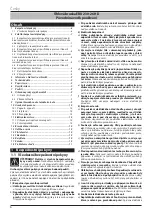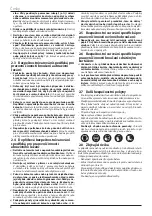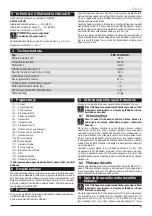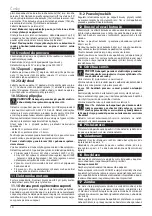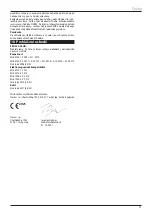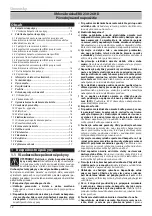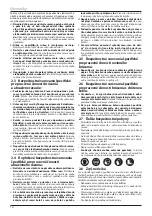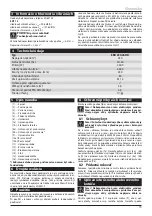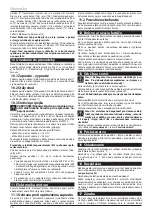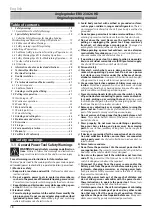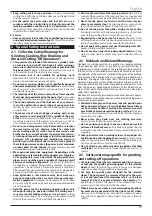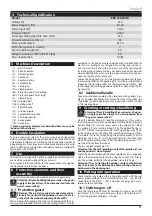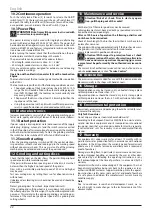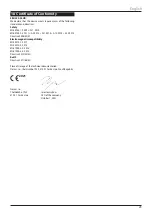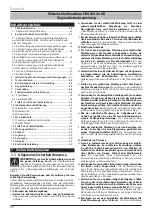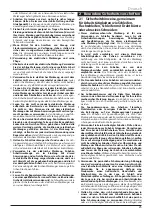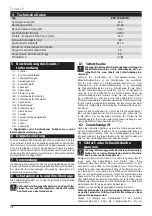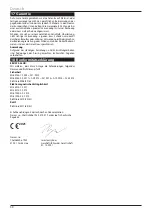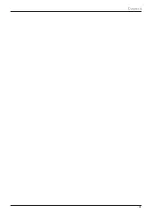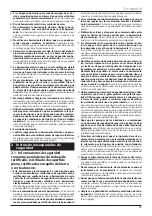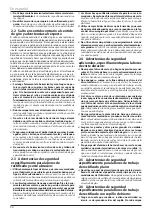
English
20
–
Wear suitable personal protective equipment:
Ear protec-
tion, protective goggles, dust mask for work that generates
dust and protective gloves when changing tools, sturdy
shoes.
2.8 Other risks
Even in cases where the machine is used correctly and all rele-
vant safety instructions have been adhered to, the design engi-
neering of the machine and its operation mean that the follow-
ing safety risks may also arise:
– Danger caused by the power cable.
– A concentration of dust which is harmful to health when
working in an area that is not sufficiently ventilated.
– Injuries caused by touching electrified parts when removing
the machine or its parts if the plugs on the power cable have
not been removed from the socket.
– You must only use original spare parts.
3 Information about noise level and
vibrations
The values have been measured in conformity with EN 60745.
EBU 230-26 HD
Acoustic pressure level L
pA
= 90.6 dB (A).
Acoustic power level L
wA
= 101.6 dB (A).
In accuracy of measurements K = 3.0 dB (A).
ATTENTION!
Noise is generated during work!
Use ear protection!
The weighted value of vibrations affecting hands and arms
a
h
= 4.51 m.s
-2
.
In accuracy of measurements K = 1,5 m.s
-2
.
The emission values specified (vibration, noise) were measured in
accordance with the test conditions stipulated in EN 60745 and are
intended for machine comparisons. They are also used for making
preliminary estimates regarding vibration and noise loads during
operation.
The emission values specified refer to the main applications for
which the power tool is used. If the electric power tool is used for
other applications, with other tools or is not maintained sufficient-
ly prior to operation, however, the vibration and noise load may be
higher when the tool is used.
Take into account any machine idling times and downtimes to esti-
mate these values more accurately for a specified time period. This
may significantly reduce the load during the machine operating
period.
d)
Always use undamaged wheel flanges that are of correct
size and shape for your selected wheel.
Proper wheel flang-
es support the wheel thus reducing the possibility of wheel
breakage. Flanges for cut-off wheels may be different from
grinding wheel flanges.
e)
Do not use worn down wheels from larger power tools.
Wheels intended for larger power tools are not suitable for
the higher speed of a smaller tool and may burst.
2.4 Additional safety instructions for
cutting-off operations:
a)
Do not “jam” the cut-off wheel or apply excessive pres-
sure. Do not attempt to make an excessive depth of cut.
Overstressing the wheel increases the loading and suscepti-
bility to twisting or binding of the wheel in the cut and the
possibility of kickback or wheel breakage.
b)
Do not position your body in line with and behind the
rotating wheel.
When the wheel, at the point of operation,
is moving away from your body, the possible kickback may
propel the spinning wheel and the power tool directly at you.
c)
When wheel is binding or when interrupting a cut for any
reason, switch off the power tool and hold the power tool
motionless until the wheel comes to a complete stop.
Never attempt to remove the cut-off wheel from the cut
while the wheel is in motion otherwise kick-back may oc-
cur.
Investigate and take corrective action to eliminate the
cause of wheel binding.
d)
Do not restart the cutting operation in the workpiece. Let
the wheel reach full speed and carefully reenter the cut.
The wheel may bind, walk up or kickback if the power tool is
restarted in the workpiece.
e)
Support panels or any oversized workpiece to minimise
the risk of wheel pinching and kick-back.
Large workpieces
tend to sag under their own weight. Supports must be placed
under the workpiece near the line of cut and near the edge of
the workpiece on both sides of the wheel.
f)
Take extra caution when making a “pocket cut” into exist-
ing walls or other blind areas.
The protruding wheel may cut
gas or water pipes, electrical wiring or objects that can cause
kickback.
2.5 Safety Warnings Specific for Sanding
Operations:
a)
Do not use excessively oversized sanding disc paper.
Follow manufacturers recommendations when selecting
sanding paper.
Larger sanding paper extending beyond the
sanding pad presents a laceration hazard and may cause
snagging, tearing of the disc or kickback.
2.6 Safety Warnings Specific for Wire
Brushing Operations:
a)
Be aware that wire bristles are thrown by the brush even
during ordinary operation. Do not overstress the wires by
applying excessive load to the brush.
The wire bristles can
easily penetrate light clothing and/or skin.
b)
If the use of a guard is recommended for wire brushing,
do not allow any interference of the wire wheel or brush
with the guard.
Wire wheel or brush may expand in diameter
due to work load and centrifugal forces.
2.7 Further safety instructions
– Check the plug and cable on a regular basis and, if they are
damaged, have them replaced by an authorised customer
service workshop.
– The switch must be in the OFF position before you connect it
to the mains.
– Always guide the power cable from the tool to the rear. Never
pull hard on the power cable and never place it on or guide it
over any sharp edges.
– Only work in a safe and stable position.
– Do not work in damp environments.
Summary of Contents for EBU 230-26 HD
Page 4: ...4 1 2 3 3 4 5 5 5 6 7a 7b 8a 8b 9 9 10a 10b 10b 11 11 12 13 14 7b 7a...
Page 5: ...5 4 6 7a 7b 8a 12 15 16...
Page 31: ...Deutsch 31...
Page 51: ...o 51 4 a 5 a 2 2 1 a...
Page 52: ...o 52 2 2 a 2 3 2 4...
Page 57: ...o 57...

